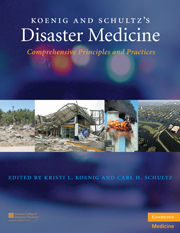Book contents
- Frontmatter
- Contents
- List of Contributors
- Contributor Biographies
- Foreword
- Preface
- Acknowledgments
- PART I CONCEPTUAL FRAMEWORK AND STRATEGIC OVERVIEW
- PART II OPERATIONAL ISSUES
- PART III CLINICAL MANAGEMENT
- SECTION A CBRNE AND HAZMAT
- SECTION B ENVIRONMENTAL EVENTS
- 32 Floods
- 33 Cyclones/Hurricanes/Typhoons
- 34 Tornadoes
- 35 Earthquakes
- 36 Tsunamis
- 37 Winter Storms
- 38 Extreme Heat Events
- 39 Volcanoes
- Index
- Plate section
- References
32 - Floods
from SECTION B - ENVIRONMENTAL EVENTS
Published online by Cambridge University Press: 05 August 2011
- Frontmatter
- Contents
- List of Contributors
- Contributor Biographies
- Foreword
- Preface
- Acknowledgments
- PART I CONCEPTUAL FRAMEWORK AND STRATEGIC OVERVIEW
- PART II OPERATIONAL ISSUES
- PART III CLINICAL MANAGEMENT
- SECTION A CBRNE AND HAZMAT
- SECTION B ENVIRONMENTAL EVENTS
- 32 Floods
- 33 Cyclones/Hurricanes/Typhoons
- 34 Tornadoes
- 35 Earthquakes
- 36 Tsunamis
- 37 Winter Storms
- 38 Extreme Heat Events
- 39 Volcanoes
- Index
- Plate section
- References
Summary
Water, water everywhere, and all the boards did shrink; Water, water everywhere, nor any drop to drink.
– Rime of the Ancient Mariner by Samuel ColeridgeOVERVIEW
Definition and Classification
Floods are defined as “the overflow of areas that are not normally submerged with water or stream that has broken its normal confines or has accumulated due to lack of drainage.”
Engineers studying past floods use statistics to estimate the chance that floods of various sizes will occur. For example, a flood found to occur on the average of 10 times in 100 years would be called the 10% chance flood or the 10-year flood. A flood that only occurs on the average of once every 100 years would have a 1% chance of occurring in any particular year and would be called the 100-year flood or 1% chance flood.
Floods are classified according to cause (high rainfall, tidal extremes, or structural failure) and nature (e.g., regularity, speed of onset, velocity and depth of water, and spatial and temporal scale). This chapter will discuss impacts according to health outcomes. The influence of flood characteristics on health impacts is discussed where appropriate.
Causes of Floods
Floods may be caused by natural processes that are either fluvial (an abundance of rainfall or melting snow) or coastal (hurricane-related storm surge, coastal inundations, or seismically induced tsunami) in origin.
Keywords
- Type
- Chapter
- Information
- Koenig and Schultz's Disaster MedicineComprehensive Principles and Practices, pp. 529 - 542Publisher: Cambridge University PressPrint publication year: 2009
References
- 3
- Cited by



